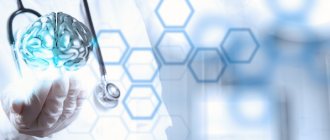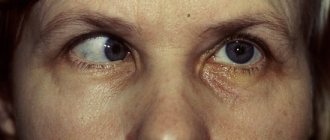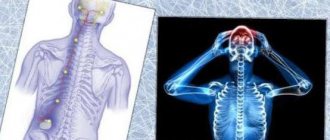Ataxia - what is it?
Features of the development of ataxia
Any movement is carried out as a result of a series of successive contractions of different muscle groups (antagonists and synergists). For alternation to be normal, the work of three elements of movement coordination is necessary:
- structures and connections of the cerebellum (the central organ of movement coordination);
- receptors that perceive the state of stretching of tendons, muscles, joint capsule and their conductors at each specific moment in time,
- impulses coming from the organ that assesses the position of the body in space (vestibular apparatus).
Depending on which of these coordination elements is affected by disturbances, a different type of ataxia develops. According to the classification, there are:
- Sensitive ataxia – disturbances in the conductors of deep muscle sensitivity;
- vestibular ataxia – damage to the vestibular apparatus;
- Cerebellar ataxia (cerebellar) – damage to the cerebellum;
- Frontal ataxia (cortical) – damage to the cortex of the frontal or temporo-occipital region.
It is customary to classify hereditary ataxias as a separate group:
- Friedreich's familial ataxia,
- cerebellar ataxia of Pierre-Marie,
- ataxia telangiectasia, or Louis-Bar syndrome.
Pathogenesis and etiology of the disease
Numerous factors lead to cerebellar damage. Genetics, vascular diseases, and atherosclerotic lesions also play a role. Ataxia often develops after severe trauma or brain surgery.
Vascular accidents, such as a heart attack or stroke, can lead to damage to any structure. Including the cerebellum. Road traffic accidents pose a particular danger. In accidents, the back of the skull hits the seat. The cerebellum is severely injured.
Causes
The main causes of damage to the cerebellum:
- Atherosclerotic vascular disease of the neck and brain;
- Heart attack or stroke;
- Infectious diseases (bacterial meningitis, viral encephalitis, borreliosis, herpes);
- Poisoning with salts of heavy metals;
- Exposure to drugs, alcohol;
- Brain tumors;
- Autoimmune diseases;
- Genetic ataxias (Friedreich, Wilson's pathology, ataxia-telangiectasia).
Causes of ataxia
Ataxia may be a consequence of:
- severe head injury (traumatic brain injury);
- accumulation of fluid in the cavities of the brain, spinal canal (hydrocephalus);
- congenital malformation of the brain/skull;
- infectious disease of the brain (encephalitis);
- cerebrovascular accidents (ischemic stroke);
- cerebral palsy;
- epilepsy in children;
- malignant neoplasms;
- abscesses.
Sensitive ataxia syndrome develops as a result of damage to:
- posterior brain stems,
- peripheral nodes,
- posterior nerves, optic thalamus,
- parietal lobe of the brain.
Cerebellar ataxia is a consequence of damage to the cerebellar vermis, its peduncles and hemispheres. Occurs in encephalitis, sclerosis.
The vestibular form of the disease is caused by damage to any part of the vestibular apparatus - nuclei in the brain stem, cortical center in the temporal lobe of the brain, vestibular nerve, labyrinth.
Cortical ataxia occurs when the frontal lobe of the brain is damaged, which is caused by disturbances in the functioning of the fronto-pontine-cerebellar system.
Hereditary types of ataxia are transmitted in an autosomal dominant or autosomal recessive manner.
Main sources of occurrence
The anomaly is associated with a malfunction in the pathways of deep sensory ability. The deviation originates in different areas of the proprioceptive system (on the back of the spinal cord, ganglia, roots, in the medulla oblongata, thalamus and cortex). The disorder is caused by vascular diseases (stroke), tumor formation, cerebral neoplasm, multiple sclerosis, and damage to the spinal cord. In some cases, sensitive ataxia appears as a result of a complication reaction after surgery. Doctors observe the development of the disease in Guillain-Barre syndrome and other types of polyneuropathy (diabetic, alcoholic, infectious-toxic type, etc.). Impaired vibration sensation can provoke symptoms of hereditary abnormalities.
Symptoms of ataxia
Each type of ataxia has its own symptoms. The sensitive form is characterized by a disorder of joint-muscular sensation in the lower extremities. Wherein:
- The patient is unsteady, bends his legs too much while walking, and takes loud steps.
- He has the feeling of walking on cotton wool/soft carpet.
- To compensate for impaired motor function, he tries to look at his feet.
- When closing the eyes, the symptoms become more pronounced.
- With severe damage to the posterior columns, movement becomes impossible.
Cerebellar ataxia is described by the following symptoms:
- While walking, the patient falls towards the affected cerebellar hemisphere.
- Staggers when walking, puts his feet very wide.
- The movements are awkward and sweeping.
- The severity of coordination disorder does not depend on vision control (symptoms are the same with open and closed eyes).
- Speech becomes slow, drawn out, handwriting becomes uneven and sweeping.
- Muscle tone decreases and tendon reflexes are impaired.
Vestibular ataxia is characterized by:
- dizziness, which intensifies even with smooth turns of the head,
- vomiting, nausea.
Frontal (cortical) ataxia manifests itself:
- unsteady walking (especially on turns),
- disturbances of smell,
- mental changes,
- lack of a grasping reflex.
Symptoms of hereditary ataxias
Pierre-Marie ataxia manifests itself similarly to cerebellar ataxia. It usually begins at the age of thirty-five. Then the first gait disturbances appear. Then problems arise with facial expressions, speech, and hand movements.
Tendon reflexes increase. Strength in the leg muscles decreases. Involuntary muscle twitches occur periodically. Vision deteriorates, intelligence decreases, and depressive disorders occur.
Friedreich's familial ataxia is manifested by increasing degeneration of the posterior and lateral trunks of the spinal systems, damage to the Gaulle's fascicles, Clark's columns and the posterior spinocerebellar tract. The patient develops an awkward, uncertain gait. He walks in a sweeping manner, deviates from the center to the sides, and places his feet wide.
Over time, changes affect facial expressions and speech. Periosteal and tendon reflexes decrease or disappear completely. Hearing gets worse. A severe course of the disease provokes damage to the heart, changes in the skeleton (frequent dislocations of joints, curvature of the legs, etc.).
Ataxia telangiectasia develops at an early age. It progresses quickly - by the age of ten the child can no longer walk. Accompanied by damage to the cranial nerves and mental retardation. Negatively affects the functioning of the immune system - the patient often suffers from bronchitis, pneumonia, rhinitis, sinusitis.
If you notice similar symptoms, consult a doctor immediately. It is easier to prevent a disease than to deal with the consequences.
Characteristics of the pathology
Cerebellar ataxia is a pathology that manifests itself primarily as a violation of motor coordination and walking. The ability to walk is built on the interaction of functions:
- Locomotion is a movement aimed at moving one’s own body in space.
- Maintaining balance.
- Adaptive reactions. Timely response to the presence of obstacles, regulation of movements taking into account changing external conditions.
There is a generalized form, when motor activity is disrupted in all parts of the body. In the local form, motor disorders affect individual parts of the body or functions - legs, arms, speech function, organs of vision. Pathology can manifest itself in one half of the body (with damage to the cerebellar tissue on one side) or in both.
Ataxia associated with damage to the cerebellum is a pathology that reflects malfunctions in the mechanisms responsible for anti-inertial regulation, which makes normal movement characteristics impossible (smoothness, regularity, accuracy, uniformity). Any normal movement is the result of the coordinated activity of several muscle groups (extensors, flexors).
Coordination of muscle activity is carried out by the cerebellum through its two-way interaction with other parts of the brain involved in the performance of motor functions and parts of the peripheral nervous system. The cerebellum is closely connected with the basal ganglia, cortical structures, and brainstem nuclei.
The transmission of information is carried out by motor neurons located in the spinal cord and proprioceptive (associated with the peripheral elements of sensory organs) neurons located in the muscles and ligaments. The cerebellum is the main coordinator of motor activity; it receives information about the planned movement, the slightest change in muscle tone and the position of parts of the body. The correct functioning of this part of the brain ensures the clarity and precision of small and complex movements.
Diseases affecting this part of the brain cause desynchronization of muscle contractions, which negatively affects the performance of any movements. Even small foci of infarction are life-threatening conditions that often provoke obstructive (associated with impaired drainage of cerebrospinal fluid) hydrocephalus.
Diagnosis of ataxia
When diagnosing ataxia, the following methods are used:
- MRI of the brain (detects atrophy of the brain stems and spinal cord, the upper parts of the vermis);
- electroencephalography of the brain (diagnoses reduction of alpha rhythm, diffuse theta and delta activity);
- electromyography (reveals axonal demyelinating damage to sensory fibers of peripheral nerves);
- DNA diagnostics (used to determine hereditary types of ataxia). By conducting indirect DNA diagnostics, doctors determine whether the ataxia pathogen can be inherited by other children in the family;
- magnetic resonance angiography (allows you to assess the integrity and patency in the cranial cavity and identify brain tumors).
Additional diagnostic procedures include consultation with a neurologist, ophthalmologist, and psychiatrist. Laboratory diagnostics for ataxia show a violation of amino acid metabolism - a reduced concentration of alanine and leucine, a decrease in their excretion in the urine.
Additional tests
For a more detailed study of the disease, a consultation with a neurosurgeon will be required, as well as a number of instrumental studies.
- In particular, a lot of information about the disease can be obtained using electroencephalography. This technique evaluates the electrical activity of various parts of the brain, which tends to change in various diseases.
- No less effective techniques are also CT and MRI of the brain. They allow you to study the structure of the brain layer by layer, detect violations of the structure of its tissues, identify ulcers, tumors, and hemorrhages.
- Magnetic resonance angiography will help detect tumors in the brain and assess the integrity of the arteries in the skull.
Treatment of ataxia
Independent treatment of ataxia, regardless of its type and severity of symptoms, is impossible. Consultation with a neurologist is required
.
Treatment is usually aimed at eliminating the causative disease, for example:
- tumor removal,
- elimination of hemorrhage,
- decreased pressure in the posterior fossa (Arnold-Chiari malformation),
- abscess removal,
- normalization of blood pressure.
In addition, it includes:
- selection of a special set of gymnastic exercises that help reduce incoordination and strengthen muscles;
- prescription of general strengthening agents - B vitamins, cerebrolysin, anticholinesterase drugs, ATP.
For ataxia telangiectasia, medications that correct immunodeficiency are prescribed, and a course of immunoglobulin is administered. Treatment of Friedreich's ataxia involves the use of medications that support mitochondrial function (vitamin E, riboflavin, succinic acid, coenzyme Q10).
Cerebellar form: features
With this form of the disease, the patient cannot coordinate movements, speech becomes chanted, and trembling of the arms, legs, and head bothers him. The disease can affect both children and adults. To clarify the diagnosis, a physical examination and instrumental studies are necessary. Ataxia cannot be completely eliminated. With the rapid development of the disease, the prognosis is negative. The exception is cerebellar ataxia, which is explained by infection.
More often the disease is detected in a hereditary form; a much smaller percentage of cases are acquired. Cerebellar ataxia can be provoked by a lack of vitamin B12, head injury, neoplasm, virus or infection, sclerosis, cerebral palsy and similar pathological conditions, stroke, poisoning with poisons, metals. Statistics show that the acquired form is more often observed after a stroke or injury. Hereditary can be explained by a gene mutation. At present there is no detailed explanation of the causes of the processes.
Danger of ataxia
Ataxia is a disease in which coordination of movements is impaired. Its progression can lead to disability and even death. Tremor of the arms and legs, severe dizziness, inability to move independently, disturbances in swallowing and defecation - all these are symptoms of pathology. In addition, ataxia leads to respiratory failure, chronic heart failure, weakened immunity and a tendency to recurrent infectious diseases.
However, it should be understood that not all patients experience obvious complications. In some cases, if you follow medical recommendations, constantly take medications and timely eliminate signs of ataxia, the quality of life of patients does not decrease and they manage to live to an old age.
Manifestations: what else are possible?
If the vestibular form develops, it can be noticed by frequent nausea and vomiting. The patient feels dizzy, this sensation becomes stronger if you turn your head, even with a smooth movement.
Cortical ataxia expresses itself as instability during movement, most pronounced when turning, disturbances in the perception of smells, as well as mental abnormalities. The patient's grasping reflex disappears.
You might be interested in: “Analgin”: what does it help with, how to use it? Instructions for use of the drug, contraindications and side effects, reviews
Prevention of ataxia
In order to prevent the birth of people with ataxia, it is necessary to avoid the birth of children in families where there are patients with a hereditary form of this pathology. Disease prevention also includes:
- exclusion of consanguineous marriages,
- timely treatment of infectious diseases,
- blood pressure control,
- refusal to engage in sports that can lead to traumatic brain injury,
- compliance with the work and rest regime, rational nutrition.
This article is posted for educational purposes only and does not constitute scientific material or professional medical advice.
How can I check the status?
If you suspect cerebellar ataxia, vestibular or any other of those described above, you need to consult a doctor for a full diagnosis. Only after a final diagnosis has been formulated can a treatment program be chosen.
If ataxia is suspected, the patient is referred to MRI to assess the state of the brain, electroencephalography and electromyography. If a hereditary form is suspected, DNA diagnostics is necessary. Based on the results of this type of indirect analysis, doctors determine how high the probability of inheriting the pathogen within the family is. The patient is also prescribed MRI angiography. If there are brain tumors, this method helps to determine them as accurately as possible.
To identify hereditary, static, cerebellar ataxia and any other form, a number of additional studies are done. The patient is examined by an ophthalmologist, neurologist, and psychiatrist. Laboratory tests can identify metabolic problems.
Forecast
The prognosis of the disease can vary significantly and depends largely on the type of disorder. Some types may remain relatively stable or even improve over time, but most will gradually get worse over many years.
Life expectancy is generally shorter than usual for people with hereditary ataxia, although some people may live into their 50s, 60s, and beyond. In more severe cases, the condition can be fatal in childhood or early adulthood.
For acquired ataxia, the prognosis depends on the underlying cause. Some cases may improve or remain the same, while other cases may gradually worsen over time and shorten life expectancy.
Cerebellar form: congenital
You can suspect a disease in a child if the efforts the baby puts into making movements are disproportionate to the action. The patient is unstable, development is slow, he begins to crawl and walk later than his peers. Nystagmus is observed, words are pronounced in syllables, clearly separated from each other. The development of speech and psyche is slowed down.
The listed symptoms may indicate not only cerebellar ataxia, but also some other pathological conditions associated with brain function. To clarify the diagnosis, it is necessary to show the child to the doctor.
Developmental anomalies
Ataxia can be observed with various developmental anomalies of the vermis and cerebellar hemispheres, as well as the brain stem. In patients with moderately severe disorders, the disease manifests itself as delayed motor development, and only later do nystagmus, ataxia and other signs appear. Additional symptoms may include mental retardation and, less commonly, spastic paraparesis.
Such developmental anomalies include:
- Arnold-Chiari syndrome.
- Dandy-Walker malformation.
- Congenital ataxia with mental retardation and spasticity.
- Congenital ataxia with episodic hyperpnea, abnormal eye movements and mental retardation.
- Congenital ataxia with mental retardation and partial aniridia (Gilespie syndrome, mechanism of inheritance unknown).
- X-linked recessive ataxia with spasticity, mental retardation and microcephaly (Paine's syndrome).
- Balance syndrome.
There is no specific treatment for these diseases. In some cases, neurosurgical intervention (shunting for hydrocephalus, etc.) is advisable.








